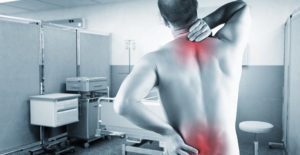Knee Pain Treatments

Most of the time, our body movements don't cause problems, but knee pain symptoms can develop from everyday wear and tear. Injuries such as a ruptured ligament or torn cartilage, and medical conditions including arthritis and gout can all cause significant knee pain. It is a symptom of overuse, injury, or a more serious condition.
Knee Pain Symptoms and Causes
Additional knee pain symptoms, and the severity of pain, vary depending on the specific cause. The most common knee injuries fall under three categories: Sprain (of a ligament), Tear (of meniscus), and Strain (of a muscle) do to strenuous, often repetitive, physical activity combined with insufficient stretching and “warming up” of the joints. Common knee pain causing conditions include bone chips, bursitis, iliotibial band syndrome, medial plica syndrome, Osgood-Schlatter Disease, osteoarthritis, and tendonitis. The knee is a complex joint made up of three bones: the femur, tibia, and patella. The interaction of these bones, the compartments between them, and the surrounding muscles provides much opportunity for knee pain and injury. Awareness and knowledge of knee pain causes lead to faster diagnosis and treatment. Many types of minor knee pain respond well to self-care measures.
Knee Pain Medical Treatment
Knee pain treatment will vary depending on the cause as well as the location of the injury, the severity, one's age, overall health condition, and normal activity level. During a physical exam, a doctor is likely to inspect the knee for knee pain symptoms like swelling, tenderness, warmth, visible bruising, and any concentration of pain. Range of motion may also be tested. The doctor will also test the knee's strength by pushing or pulling on the joint to evaluate the integrity of the knee's structures. Additionally, x-rays, CT scans (computerized tomography), ultrasounds, and MRIs (magnetic resonance imaging) may also be required, as well as lab tests if an infection or gout is suspected.
Once the physician determines a likely cause for the knee pain, he or she may prescribe medications to relieve pain and treat underlying conditions. Physical therapy may be required to strengthen the muscles surrounding the knee and increase stability and improve balance. Orthotics and bracing, such as arch supports, can help to shift pressure away from the knee injury. Injections of corticosteroids or hyaluronic acid may help reduce knee pain symptoms due to arthritis and add lubrication to the joint. In severe cases, arthroscopic surgery or partial or total knee replacement surgery may be the only suitable knee pain treatment.
Knee Pain Lifestyle and Home Treatment
In minor cases, one can begin home knee pain treatment with over-the-counter medications, such as acetaminophen (Tylenol), ibuprofen (Advil, Motrin), and naproxen (Aleve), which may help relief the pain. Rubbing the knees with creams containing lidocaine, a numbing agent, or capsaicin, a heating agent, may also relieve knee pain symptoms. Extended self-care measures for an injured knee begins with rest. Take a break from normal activities in order to reduce stress and strain on the knee and give the injury time to heal. Icing a painful or swollen knee for 20 minutes at a time numbs the joint and reduces inflammation. Wrapping the knee with a compression bandage helps prevent fluid buildup and maintains joint stability. And elevating the knee drains fluids away to help reduce swelling and other knee pain symptoms.
Alternative knee pain treatment may include taking glucosamine and chondroitin, though study results have been mixed about the effectiveness in relieving pain. Those who have moderate to severe arthritis pain appear to be helped more often than those with minor arthritis pain. Although there is no way to guarantee avoiding knee pain, one can try to keep extra pounds off, stay limber by routinely stretching joints, and strengthen the surrounding muscles with appropriate, moderate exercise.








